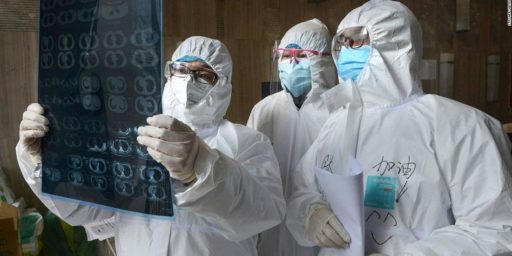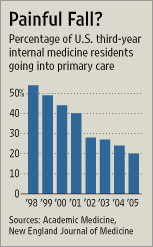Dying Baby Saved By 3-D Printer
Yet another achievement for a technology that seems to have just burst upon the scene yesterday:
(CNN) – When he was 6 weeks old, Kaiba Gionfriddo lay flat on a restaurant table, his skin turning blue. He had stopped breathing.
His father, Bryan, was furiously pumping his chest, trying to get air into his son’s lungs.
Within 30 minutes, Kaiba was admitted to a local hospital. Doctors concluded that he had probably breathed food or liquid into his lungs and eventually released him.
But two days later, it happened again. It was the beginning of an ordeal for the Youngstown, Ohio, family that continued day after agonizing day.
“They had to do CPR on him every day,” said April Gionfriddo, Kaiba’s mother, who later found out her son had a rare obstruction in his lungs called bronchial malacia. “I didn’t think he was going to leave the hospital alive.”
And here’s where the amazing part comes in:
With hopes dimming that Kaiba would survive, doctors tried the medical equivalent of a “Hail Mary” pass. Using an experimental technique never before tried on a human, they created a splint made out of biological material that effectively carved a path through Kaiba’s blocked airway.
What makes this a medical feat straight out of science fiction: The splint was created on a three-dimensional printer.
“It’s magical to me,” said Dr. Glenn Green, an associate professor of pediatric otolaryngology at the University of Michigan who implanted the splint in Kaiba. “We’re talking about taking dust and using it to build body parts.”
Kaiba’s procedure was described in a letter published in the most recent issue of the New England Journal of Medicine.
“It was pretty nifty that (doctors) were able to make something for Kaiba on a printer like that,” April Gionfriddo said. “But we really weren’t so worried about that. We were more worried about our son.”
Green, who has been practicing for two decades, and a UM colleague, biomedical engineer Scott Hollister, had been working for years toward a clinical trial to test the splint in children with pulmonary issues when they got a phone call from a physician in Ohio who was aware of their research.
“He said, ‘I’ve got a child who needs (a splint) now,’ ” referring to Kaiba, said Green. “He said that this child is not going to live unless something is done.”
(…)
What followed in Kaiba’s case was a painstaking process of creating the splint on the printer in layers. Information about each layer is transmitted from the computer to a laser beam, which melts the PCL into a 3-D structure.
“We can put together a complete copy of a body part on the 3-D printer within a day,” Green said. “So we can make something very specific for a patient very quickly.”
Green then took the splint, measuring just a few centimeters long and 8 millimeters wide, and surgically attached it to Kaiba’s collapsed bronchus. It was only moments before he saw the results.
“When the stitches were put in, we started seeing the lung inflate and deflate,” Green said. “It was so fabulous. There were people in the operating room cheering.”
“This case is a wonderful example that regenerative technologies are no longer science fiction,” said Dr. Andre Terzic, director of the Mayo Clinic Center for Regenerative Medicine, who was not involved in Kaiba’s case. “We are increasingly … finding new solutions that we didn’t have before.”
The technique used by Green and Hollister is part of a burgeoning field called regenerative medicine, which involves engineering therapies — using things like stem cells, or “body parts” constructed out of biological material — to harness the body’s ability to heal itself.
We’ve written here several times about the revolutionary impact that 3-D printers are having in the area of gun regulation. Here we have an example of how they are just starting to have impacts in other areas. This is an regenerative splint. Someday, maybe, we’ll be talking about “human” tissues and perhaps entire organs created artificially. The lives this could save are uncountable, and the potential of this technology is unfathomable.
Kaiba Gionfriddo is alive today because of a 3-D printer, something that didn’t exist 20 years ago and was still theoretical a decade ago. In either era, he’d most likely be dead today. That’s just amazing.
Found via Facebook






Pretty cool.
What fascinates about this is it is one of those things that comes straight from science fiction. One of my favorite scifi writers is L.E.Modisitt. He has been writing about “replicators” for years in his fiction but not only that he has speculated about the societal implications of not needing people to make things.
We need to repeal the 3.5% tax on GROSS (yes, you heard me gross, not net) profits that Obamacare levies on medical devices. Innovation like this needs to be supported and a new company needs every penny it can generate to expand and develop amazing things like this.
This is what the 3d printing movement is all about!
Now I’m thoroughly convinced that this is going to be the biggest revolution in human technological history since Gutenberg’s press… and probably bigger than that.
Now if only government wouldn’t muck things up.
3D printing is a little too good, which means eventually big companies are going to realize it will hurt their revenue, then they will get the politicians involved and it will become heavily regulated and much less useful.
“something that didn’t exist 20 years ago” The first time I bought one was about twenty two years ago. A 3D Systems stereolithography machine. Expensive, but more capable than the Makerbot sort of thing the gun maker was using. There seems to be a general rule that it takes about twenty years for a new technology to go from unique niche, specialist supported applications to general use. Think of airplanes, electric motors, PCs. This also required the parallel evolution of solid model Computer Aided Drafting from dedicated workstations at GM and Boeing to any desktop.
Someday, maybe, we’ll be talking about “human” tissues and perhaps entire organs created artificially.
This has actually been talked about inside the industry extensively and already achieved – it just hasn’t gone mainstream…….yet.
http://www.ted.com/talks/anthony_atala_printing_a_human_kidney.html
It’s is good that you spread the news, but it’s kind of a backwards report. There are many areas where 3d printing is making a difference. The gun thing is just overrated. Did you hear about the extended tests with a consumer printed gun? It fired several times, but between shots spent cartridges had to be driven out with a hammer, and it had a few misfires in the short test.
Two months from now he’ll get a bill for $340,682 and a letter from the insurance company saying “we do not cover procedures deemed experimental or non-standard”.
“…something that didn’t exist 20 years ago and was still theoretical a decade ago.”
But Doug, 3D printing did exist 20 years ago. In fact, most of the technologies collectively known as “3D printing” have been around for almost 30 years. Selective Laser Sintering, the 3D printing technology described in this article, was developed in the mid-1980s. Stereolithography, the first 3D printing technology, just celebrated its 30th anniversary of existence (though it was commercialized a few years after its proof of concept).
My employer has been providing 3D printing services and selling 3D printing machines for its almost two decades of existence; we were doing it back when it was called “rapid prototyping” or “additive manufacturing.” What is new is the deluge of the commercial (as opposed to industrial) 3D printers, such as Makerbot, based on Fused Deposition Modeling technology (developed by Dr. Scott Crump in the late 1980s) and people thinking more “outside the box” as they apply these 25-30 year old technologies.
Fantastic, literally.
I bet the FDA will put all of them in jail now, as this device did not go through 20 years of testing.
Or maybe they’ll get audited by the IRS.
@Chester White
Obama thugs already got to them, they are in a FEMA camp. Biden parachuted in with the assault team…
@gVOR08: It should be noted that the 3D printed gun demonstrated by Defense Distributed was not built on a “Makerbot sort of thing” but on a Stratasys Dimension SST. Though purchased used by DD for $8000, the Dimension SST retails new for about $30,000 (cite: my company sells the things). The price gap between Dimension and Makerbot is reflected in the much higher quality output of the Dimension 3D printers, most notably part strength and layer resolution. It would be very foolish to fire a 3D printed gun made on a Makerbot and, to be honest, I wouldn’t encourage firing one made on a Dimension either.
In May 2010 my mother and I took a trip to Israel. On the flight home, Mom (who is a very friendly sort) asked the guy sitting next to her why he was going to the USA. He said he was going over to demonstrate his company’s new product, a “3D printer.” As he explained it, I felt my heart accelerating, and said, “Mom, are you getting this? He’s describing a REPLICATOR!”
Of course, it’s a long way from here to the Federation of Planets, but I’m happy to be seeing at least some of it come true…
@timx: Also see, For the first time scientists have printed human embryonic stem cells using a 3D printer.
@Ron Beasley:
For a good take on the moment immediately following the dawn of the new “print” revolution, I’d suggest Cory Doctrow’s “Makers.”
@DensityDuck:
It depends. If he has private insurance, there’s a good chance it will be covered, because private insurance companies are fairly good at recognizing the need of experimental or non-standard procedures, when there is no other hope.
Of the one or two times that I’ve heard of an insurance company refusing to cover experimental or non-standard procedures, it’s been a State-provided company doing the refusal. (One prominant case in Utah, involving a police officer who had cancer, and sought non-standard therapy because he exhausted standard medical options, comes to mind.)